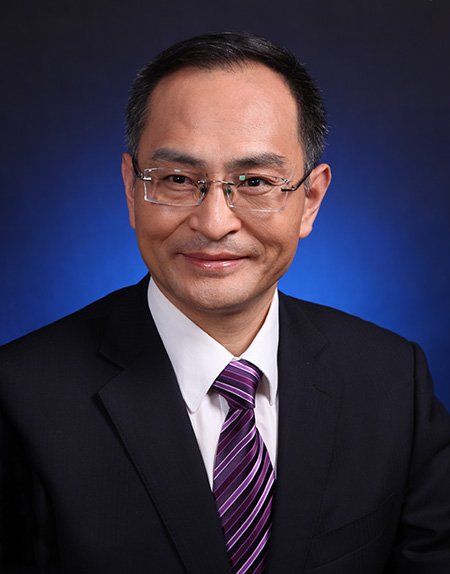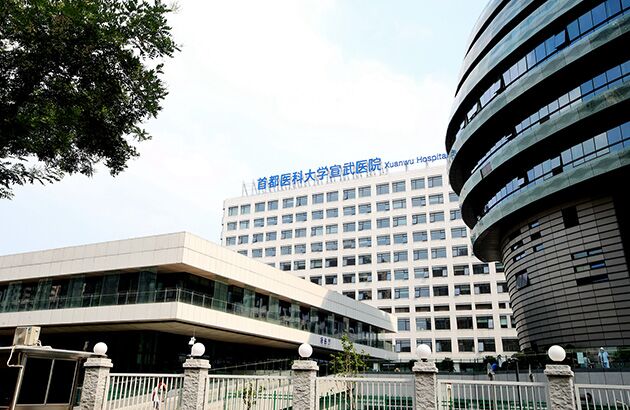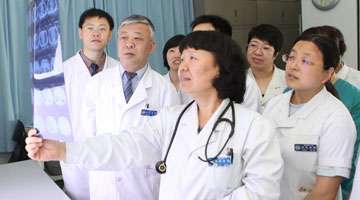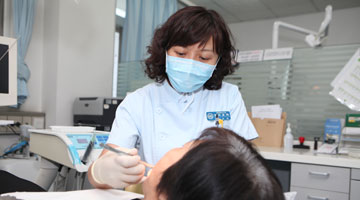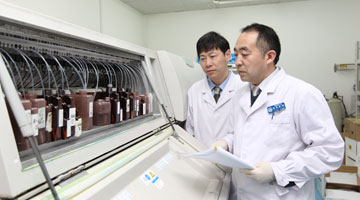专业介绍
心脏内科专业介绍
宣武医院心内科历经60年发展历程,建院伊始,在国内著名心血管病专家汪家瑞教授带领下始创心内科,从无到有,从小到大,逐步发展成为专业齐全、技术精良、诊疗规范、学科特色鲜明、医教研并举、国内知名的心脏学科。心内科涵盖重症监护、冠脉介入、心脏起搏与电生理、超声心动、无创心电检查、心脏康复等专业组。年门诊量、住院患者量和手术量、介入治疗量等均居首都三级甲等综合医院前列。
心脏重症的前身是冠心病监护病房(CCU),顺应老龄化和多合并疾病及疾病谱的变化,CCU正向CICU发展,CCU与ICU技术、理念和诊疗模式融合,从感染、营养支持、镇静、循环辅助(IABP、ECMO)、有创和无创呼吸辅助、床旁血液滤过、床旁超声血流动力学评估等全方位对心血管危重症患者进行管理,显著提升了危重症患者的救治水平,成为医院国家临床重症医学专科的重要组成部分和心血管专业发展的重要支撑。
心内科开展冠心病的介入治疗二十余年,至今已完成几万例冠脉诊疗,并取得非常好的效果。运用旋磨、激光、血管内超声(IVUS)、光学相干断层成像仪(OCT)和血流储备分数(FFR)等当今先进的病变评价和治疗技术手段实施CTO等冠脉复杂病变的介入治疗,取得非常好的疗效。心内科已经成为全国冠脉介入诊疗技术培训基地。
起搏与电生理专业组在起搏器治疗缓慢心律失常方面拥有极其丰富的经验,能够很好的完成双腔及三腔起搏器、植入型体内自动除颤器等国内先进仪器的安装,取得了良好的疗效。特别指出的是,近几年,在射频消融治疗快速心律失常方面心脏科取得了巨大的发展。运用先进的三维电生理射频消融仪完成频发室早、室速、室上速、房扑、房颤等多种心律失常疾病的治疗,治疗例数及疗效位于北京前列。心内科已经成为全国心律失常介入专业培训基地。
心内科拥有国内先进的心脏超声设备和经验丰富的专家。除完成一般超声检查外,还常规开展床旁心脏超声、经食道心脏超声、右心声学造影检查、心脏手术术前术后血管评估、心脏外科及神经外科手术术中监测等工作。
作为首都医科大学第一临床学院,心脏内科承担了物理诊断学和心血管临床医学的教学任务,是最早的住院医师规范化培训基地,拥有一大批临床经验丰富、教学能力超强的老师,赢得了诸多的荣誉和良好的口碑。心内科也是首都医科大学最早设置硕士和博士生培养点的学科,先后培养硕士、博士、博士后近百人。
在“争创国内一流,国际知名的学院型医院”方针的指导下,心内科始终重视科研对学科发展的助推作用。心血管病研究室创立于1986年, 1988 年在国内首次发现并分离、提取了人类白细胞血管紧张素Ⅱ物质,建立了血浆肾素活性的检测方法;率先在国内提出国人老龄化进程中心功能及心脏结构的衍变特点、心包具有合成、贮存、分泌心钠素的功能、单纯性收缩期高血压主要表现为舒张功能损害、舒张期高血压主要表现为收缩功能损害、生理性舒张功能减退与舒张性心力衰竭的鉴别诊断及临床意义等观点。在高血压病个体化治疗、心脏结构、血流及功能与循环心钠素及肾素-血管紧张素系统关系、急性心肌梗死溶栓纤溶系统监测等方面作了许多有意义的工作。心内科同时承担了多项科研基金项目,并取得了丰厚的成果。先后承担国家攻关、国家自然科学基金、首都医学发展基金重大课题、市科委、市教委、市卫生局、首医大基临课题等二十余项,获得市部级以上科技进步奖十余项。
现在,宣武医院正进入新的历史发展时期,心内科将依托国家老年医学中心和神经学科优势,在老年心血管病和心脑共病及跨学科诊疗领域拓展、创新,形成新的学科发展优势及新型诊疗模式,造福患者。
The Department of Cardiology of Xuanwu Hospital has gone through a 60-years of development. From the beginning of its establishment, under the leadership of Professor Wang Jiarui, the famous expert on cardiovascular disease in China, the Department of Cardiology was founded and gradually developed into an integrated well-known cardiovascular discipline, with professional and advanced technology, standardized diagnosis and treatment, distinctive characteristics, along with its medical teaching and research in China. Cardiology includes intensive care, coronary intervention, cardiac pacing and electrophysiology, echocardiography, non-invasive ECG examination, cardiac rehabilitation and other professional groups. The annual number of out-patient, inpatient , operation and interventional treatment are all ranked at the top list of capital Grade 3A general hospital.
To response to aging and changes of disease spectrum and many complications diseases, the coronary heart disease intensive care unit, which previously known as CCU, is developing to CICU. CICU has combined ICU technology, concept and diagnosis and treatment mode, through multiple management including infection control, nutritional support, auxiliary cycle (IABP, ECMO), invasive and noninvasive respiratory support, bedside hemofiltration, bedside ultrasound hemodynamic evaluation, etc. CICU has significantly improved the treatment level of critically ill patients, and becomes an important part of the national clinical specialty in intensive care and an important supporter for the development of cardiovascular specialty.
The interventional therapy of coronary heart disease has been carried out for more than 20 years in Department of Cardiology. Tens of thousands of cases of coronary artery disease have been diagnosed and treated so far, and achieved very good results. The interventional therapy technology of rotablator, laser, intravascular ultrasound ( IVUS ), optical coherence tomography (OCT) and Fractional flow reserve (FFR) have been widely used in complex lesions coronary artery such as CTO. Department of Cardiology has become the national training base of coronary intervention technology.
The cardiac pacing and electrophysiological specialty group has rich experience in treatment of bradyarrhythmia with pacemakers, and can well complete the installation of advanced instruments such as dual-chamber and three-chamber pacemakers and implantable cardioverter-defibrillator (ICD). Good curative effect has obtained. Particularly, great progress has been made in radiofrequency ablation in the treatment of tachyarrhythmias in recent ten years. Advanced three-dimensional electrophysiologic radiofrequency ablation apparatus was used to complete the treatment of frequent ventricular premature, ventricular tachycardia, supraventricular tachycardia, atrial flutter, atrial fibrillation and other arrhythmia diseases. The number of cases and effect were in the forefront of Beijing. Department of Cardiology has become the national arrhythmia intervention professional training base.
Department of Cardiology has advanced cardiac ultrasound equipment and experienced experts. In addition to the general cardiac ultrasound examination, we also complete lots of bedside echocardiography, transesophageal echocardiography, right ventricular contrast echocardiography, preoperative and postoperative vascular assessment, operation monitoring of cardiac and neurosurgical surgery .
As the first clinical hospital of the Capital Medical University, the Department of Cardiology undertakes the teaching tasks of physical diagnostics and cardiovascular clinical medicine, and is the earliest standardized training base for residents, has lots of experienced teachers. Department of Cardiology is also the first to set up master's degree and doctoral training point discipline of the Capital Medical University, and has trained students who obtained master's degree, doctoral and postdoctoral degree nearly 100.
With the guideline of "striving to first-class and famous collegiate hospital internationally ", Department of Cardiology always attached importance to the role of scientific research in promoting the development of disciplines. The cardiovascular laboratory was established in 1986 . In 1988, angiotensin II in human leukocytes was been isolated and extracted for the first time in China, and established a method for plasma renin activity. It was first proposed that the central function of aging process and the evolution of cardiac structure in China, the pericardial function of synthesizing, storing and secreting atrial natriuretic peptide, and the isolated systolic hypertension mainly manifested diastolic function damage. The diastolic hypertension manifested systolic dysfunction, the difference of physiological diastolic dysfunction and diastolic heart failure. individualized treatment of hypertension, the relationship between cardiac structure, blood flow and function and circulating atrial natriuretic peptide (ANP) and renin-angiotensin system, and the monitoring of thrombolytic and fibrinolytic system in acute myocardial infarction (AMI). At the same time, Department of Cardiology has successively undertaken more than 20 national key research projects, the national natural science foundation, the capital medical development fund, the municipal science and technology commission, the municipal education commission, the municipal health bureau, and the basic and temporary projects of the first medical university, and we have won more than ten scientific and technological progress awards at or above the ministerial level.
Now, Xuanwu Hospital is entering into a new historical period of its development, the Department of Cardiology will take the advantages of the National Geriatrics Center and neuroscience, expanding and innovating in the fields of cardiovascular diseases, and diagnosis and treatment in cardio-cerebral co-diseases interdisciplinary in the elderly. the Department of Cardiology will strengthen the new discipline development and innovated diagnosis and treatment pattern , to benefit our patients.






